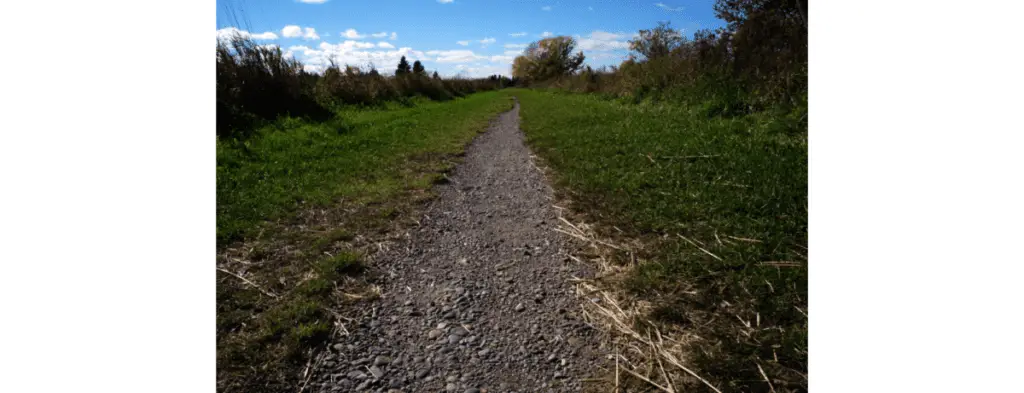
There is no denying that you can spend a lot to build a walkway. However, a simple gravel trail is easy to make and doesn’t cost a fortune. Read on to find out more about how to make a garden path with gravel.
What to put under a gravel path?
You have to use a membrane under your gravel path. As such, it will prevent weeds and will not allow natural elements to penetrate the soil underneath. Apart from that, it keeps the gravel clean by creating a strong barrier. Typically, you can have two types of membrane: a heavy-duty polypropylene and a weed suppressant.
Commonly used in domestic landscaping projects, the weed suppressant fabric is great for gravel paths with moderate pedestrian traffic. On the other hand, heavy-duty polypropylene is a tough fabric that is designed to handle certain areas and driveways that receive heavy foot traffic.
When it is about laying the membranes in the right way, it is important to prepare the ground first. Make sure that there is no vegetation around and remove sharp or stalk objects. Also, keep in mind that the membrane will manage to control most weeds except for surface seeded invasive weeds.
For them, the only solution is weed killer. Also, in certain areas in your garden, you may require a double layer of membrane or double the gravel covering depth.
How to prepare the ground for gravel
Below is the process of how you can prepare the ground for your new gravel path.
- The first step is to start outlining the path’s shape by using a garden hose, spray paint, or the length of a rope
- Use a square-shaped spade to remove soil within the border. A depth of 4 inches should work well
- Next, you have to form the trench. Again, use a square-shaped spade so that the sides of the trench stay straight and the bottom remains even as possible
- Clear all types of vegetation. This includes normal grass along with other plants and weeds
- Remove weeds and take out the plants that you want to keep. Introduce them to your desired place in the garden. Find the best ways to remove weeds in this article.
- Slightly dig over the ground a few times to make sure that the condition of the top layer of soil is retained well
- Make the ground surface even and break up all kinds of bumps and lumps. Occasionally check the depth of the path with a measuring tape as you proceed
- You can add coarse sand to improve drainage if you want
- Dig an outside border of about 2 inches deep and 4 inches wide to separate the path from a specific garden feature that you like to keep. It might be a flower bed, a rockery, a patio, or a grasses patch
- Lastly, lay a membrane over the area and secure it with staples or gravel.
How deep should the gravel be?
3 to 4 inches deep of gravel is considered sufficient for weed suppression.
As for the gravel size it is better to stick with something that will be under a three-fourth inch. As such, it will provide you with the best circumstance and comfortability to walk on. Besides, the small stones can make the path smooth and soft to walk on.
Whereas, the large stones are better when it comes to windy and rainy conditions. Flat slates are what you should get for the inclines because they won’t’ slide or shift around. It is recommended to buy gravel from a landscaping supplier or local quarry so that you get the best deal possible.
Apart from that, work with them and seek their advice so that you can have the right material to fulfill your ambition of having an amazing gravel path.
What kind of gravel to use?
Choosing the right kind of gravel is important when it comes to the overall appearance of your path. For Japanese types of gardens, gray limestone gravel works well and looks clean. For gardens that are blessed with the goodness of warm hues like the colored flower beds, pink, red, buff, and golden are good options.
If you are looking for that intense, dramatic appearance, why not choose a colored glass aggregate that makes your garden beautiful and unforgettable. Moreover, when you work with sand and rock gardens, gold, brown, and red are traditional. Still, you can add a beautiful contrast to your garden by including black lava rock or white marble.
How wide should a garden path be?
The appearance of your gravel path doesn’t only depend on the materials, but it depends on the design as well. The first thing that you should do is think about a layout regardless of how it will be. It can be a straight line across the garden or a walkway through it.
You can do the layout by considering the ropes, strings, or garden hoses alongside your planned pathway. However, don’t put your path on steep inclines because the gravel won’t stay in its place. The next important thing that you should have to consider is how wide the path must be.
If you look around at most gardens that are made of gravel paths, you can notice that they are 3 to 4 feet wide. However, a gravel path with a width of at least one and a half feet wide is needed for comfortable walking.
Moreover, there are no guidelines about the standard width of a gravel path. That way, you can have as wide a path as you like. But a gravel path that’s over 4 feet wide, doesn’t look good and many gardeners avoid it.
To add a more visual appearance to your gravel path, you can adjust its width at certain points. As such, it gives the scope for the visitors to stand at a particular point and have a look at the garden. For example, some gravel paths have the widest points near the porch.
Looking to create a different type of garden path? Check out this article.
This post contains affiliate links. If you make a purchase through these links, we may receive compensation at no additional cost to you.

